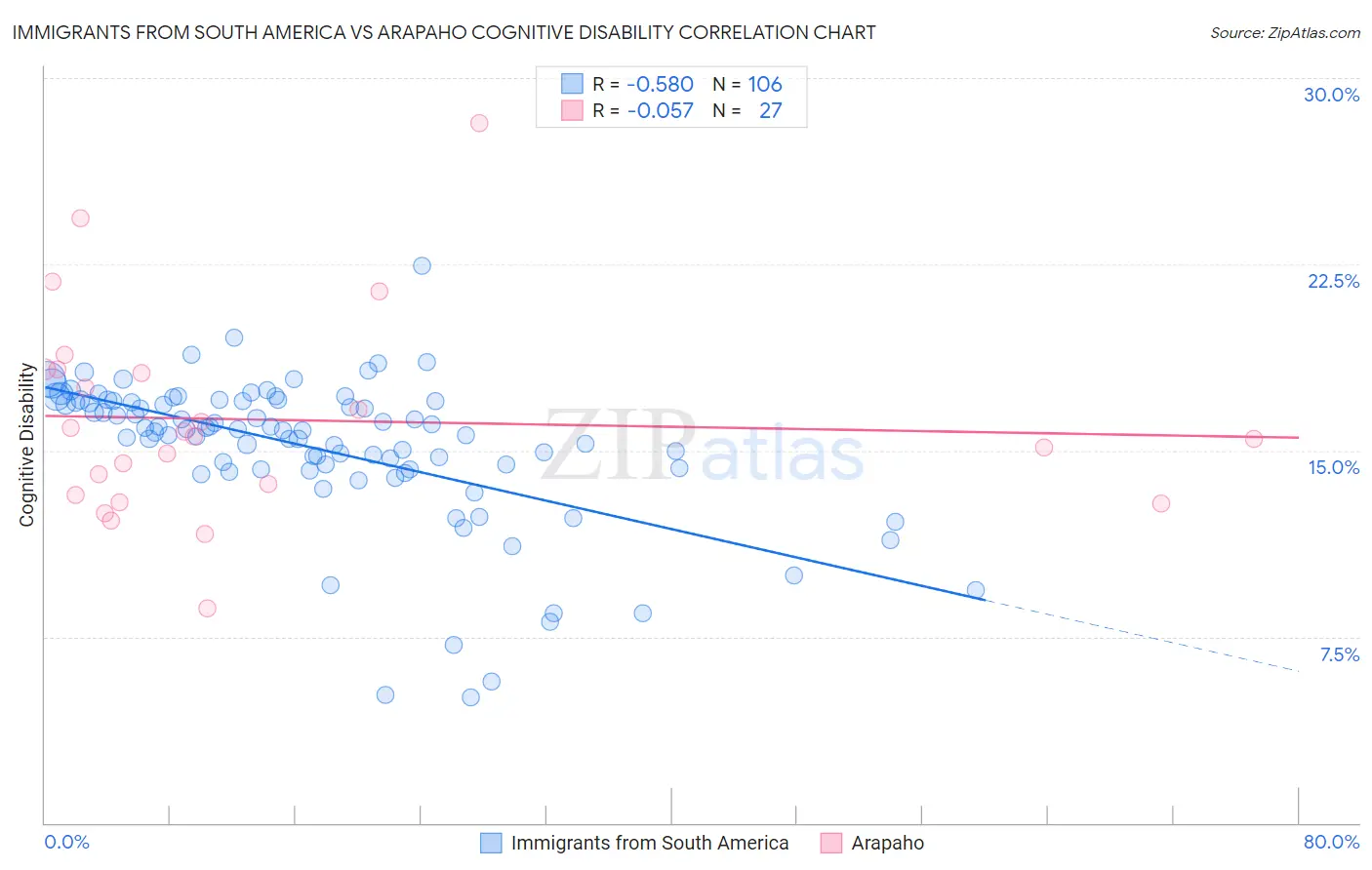Immigrants from South America vs Arapaho Cognitive Disability
COMPARE
Immigrants from South America
Arapaho
Cognitive Disability
Cognitive Disability Comparison
Immigrants from South America
Arapaho
16.7%
COGNITIVE DISABILITY
98.8/ 100
METRIC RATING
92nd/ 347
METRIC RANK
16.8%
COGNITIVE DISABILITY
97.3/ 100
METRIC RATING
110th/ 347
METRIC RANK
Immigrants from South America vs Arapaho Cognitive Disability Correlation Chart
The statistical analysis conducted on geographies consisting of 486,335,122 people shows a substantial negative correlation between the proportion of Immigrants from South America and percentage of population with cognitive disability in the United States with a correlation coefficient (R) of -0.580 and weighted average of 16.7%. Similarly, the statistical analysis conducted on geographies consisting of 29,780,325 people shows a slight negative correlation between the proportion of Arapaho and percentage of population with cognitive disability in the United States with a correlation coefficient (R) of -0.057 and weighted average of 16.8%, a difference of 0.58%.

Cognitive Disability Correlation Summary
| Measurement | Immigrants from South America | Arapaho |
| Minimum | 5.1% | 8.6% |
| Maximum | 22.5% | 28.2% |
| Range | 17.4% | 19.5% |
| Mean | 15.1% | 16.2% |
| Median | 15.8% | 15.6% |
| Interquartile 25% (IQ1) | 14.2% | 13.2% |
| Interquartile 75% (IQ3) | 17.0% | 18.3% |
| Interquartile Range (IQR) | 2.8% | 5.0% |
| Standard Deviation (Sample) | 3.0% | 4.1% |
| Standard Deviation (Population) | 3.0% | 4.1% |
Demographics Similar to Immigrants from South America and Arapaho by Cognitive Disability
In terms of cognitive disability, the demographic groups most similar to Immigrants from South America are Immigrants from Southern Europe (16.7%, a difference of 0.0%), Danish (16.7%, a difference of 0.010%), Asian (16.7%, a difference of 0.050%), English (16.8%, a difference of 0.11%), and Finnish (16.8%, a difference of 0.13%). Similarly, the demographic groups most similar to Arapaho are Albanian (16.8%, a difference of 0.010%), Uruguayan (16.8%, a difference of 0.010%), Canadian (16.8%, a difference of 0.060%), Immigrants from Nicaragua (16.8%, a difference of 0.14%), and Northern European (16.8%, a difference of 0.17%).
| Demographics | Rating | Rank | Cognitive Disability |
| Danes | 98.8 /100 | #91 | Exceptional 16.7% |
| Immigrants | South America | 98.8 /100 | #92 | Exceptional 16.7% |
| Immigrants | Southern Europe | 98.7 /100 | #93 | Exceptional 16.7% |
| Asians | 98.7 /100 | #94 | Exceptional 16.7% |
| English | 98.6 /100 | #95 | Exceptional 16.8% |
| Finns | 98.5 /100 | #96 | Exceptional 16.8% |
| Dutch | 98.5 /100 | #97 | Exceptional 16.8% |
| Immigrants | Lebanon | 98.4 /100 | #98 | Exceptional 16.8% |
| Jordanians | 98.2 /100 | #99 | Exceptional 16.8% |
| Immigrants | Russia | 98.2 /100 | #100 | Exceptional 16.8% |
| Immigrants | Asia | 98.1 /100 | #101 | Exceptional 16.8% |
| Irish | 98.1 /100 | #102 | Exceptional 16.8% |
| Paraguayans | 98.0 /100 | #103 | Exceptional 16.8% |
| Palestinians | 98.0 /100 | #104 | Exceptional 16.8% |
| Immigrants | Eastern Asia | 97.9 /100 | #105 | Exceptional 16.8% |
| Northern Europeans | 97.8 /100 | #106 | Exceptional 16.8% |
| Immigrants | Nicaragua | 97.8 /100 | #107 | Exceptional 16.8% |
| Canadians | 97.5 /100 | #108 | Exceptional 16.8% |
| Albanians | 97.3 /100 | #109 | Exceptional 16.8% |
| Arapaho | 97.3 /100 | #110 | Exceptional 16.8% |
| Uruguayans | 97.2 /100 | #111 | Exceptional 16.8% |